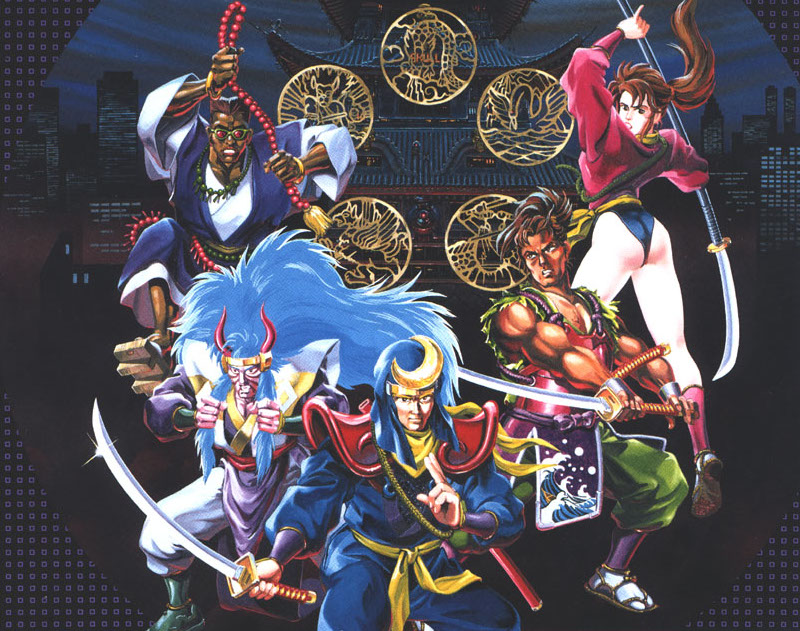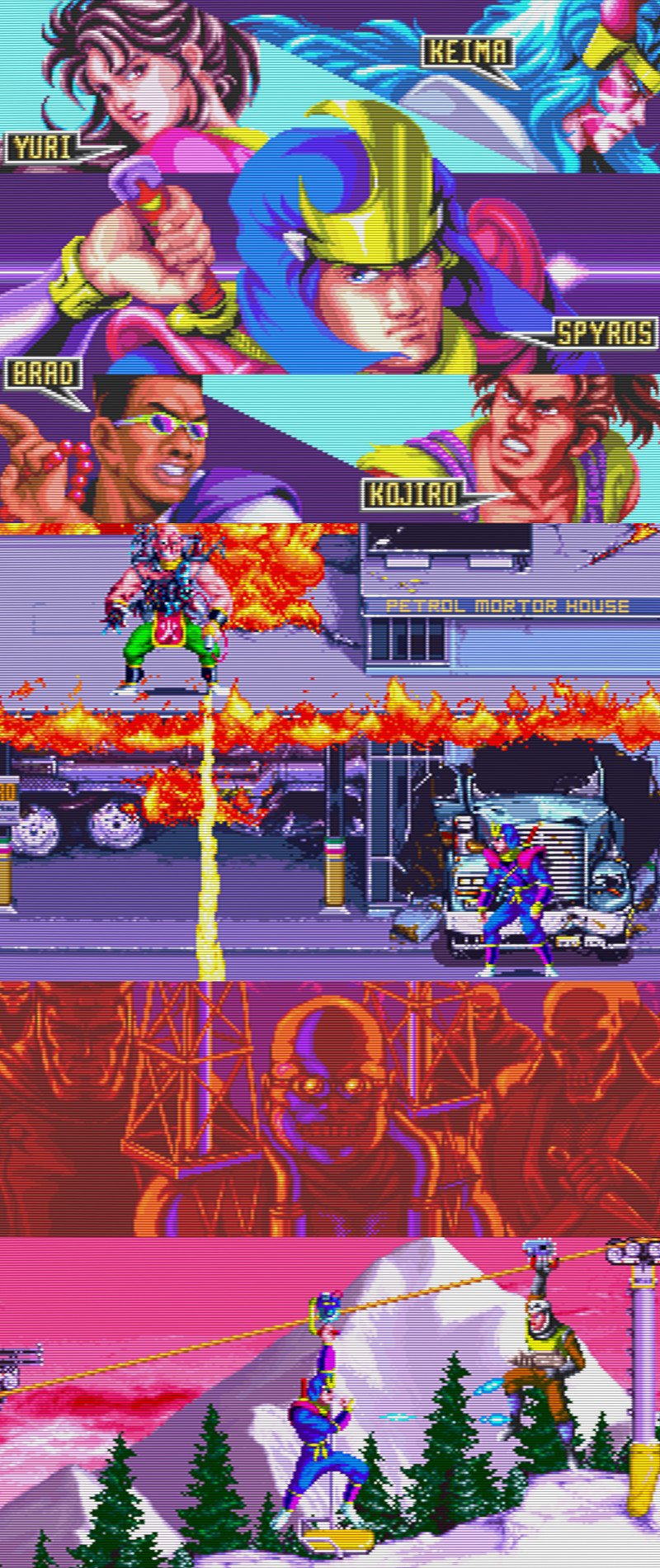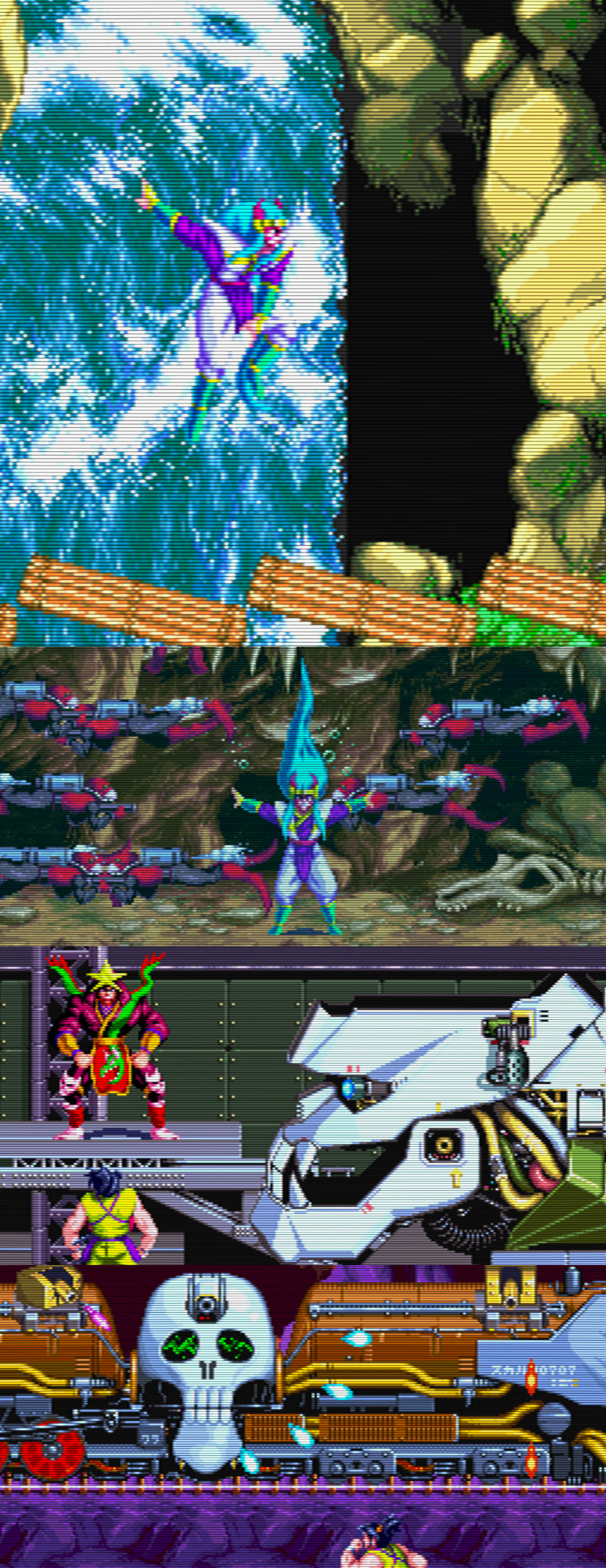
Mystic Warriors (1994, Konami)
The flat, horizontal level design I lightly criticized in my Roosters review is present here in Mystic Warriors as well. You run, jump, roll, climb and autoscroll on an almost purely left-to-right basis through the entire game. There is one very important difference here, though, and that is the enemy placement. In Roosters and its close relation Daimakaimura, though they have predetermined spawn points for some bad guys, rely on zones within stages that have infinitely respawning enemies coming from the ground or the sides of the screen. If you hang out in one spot, enemies will come after you like a ruthless mob, completely unplanned. Mystic Warriors, much like its immediate predecessor Sunset Riders, has very little randomness. Every enemy spawns from a predetermined location in the stage, which lends itself to a more methodical, memorization-based playstyle than one based on reaction. This allows for a greater degree of control on the part of the designer to shape the experience of the player; within this genre, the mindless appearance of endless hordes of enemies is less interesting than carefully constructed encounters and setpieces.
This aspect is also much of what attracted me to the game Shinobi. In fact, this game more or less plays like a suped-up version of it, both mechanically and aesthetically. In addition to the fixed enemy placement you get shurikens to throw (this time rapid fire), a melee attack (this time with the ability to cancel enemy bullets), and a plane-swapping jump-up and jump-down command, all wrapped up of course in a ninja theme (this time much more vibrant and interesting). Mystic Warriors also sports a roll/slide/dash (depending on your character), a carry-over from Sunset Riders. Instead of having ninja magic that you can use once per stage at the press of a button, however, there are only predetermined magic pickups that activate upon collection, which feel oddly superfluous most of the time.
Despite the ninja theme, the game feels more in line with Saturday morning cartoons than anime, continuing in the tradition of the TMNT games and Wild West Cowboys of Moo Mesa, which are literally based on Saturday morning cartoons of course. It's decked out in thoroughly bright pastel colors, all quite well animated. The game is fairly lengthy and has many stages, each with a distinct setting. Your enemies are a little samey, consisting primarily of palette swapped dudes in helmets donning knives or guns, and ninjas with bare skulls for heads, with occasional appearances by scuba divers and sexy women who throw dynamite at you. However the boss fights are, more often than not, impressive setpieces, and quite plentiful due to the large number of stages.

The music has the usual Konami trademarks of orchestra hits and unrestrained arpeggios during boss battles, but the stages are scored with smooth sounding techno adorned with classical Japanese motifs. The result is a diverse set of absolute fucking jams that never get old. Music-wise, this is peak Konami. A slight downside of it consisting of all PCM samples and no synths is that it had to be compressed to fit on a rom, so it sounds a bit crunchy in-game. A small consolation is the existence of a CD soundtrack that has every track in all its uncompressed glory.
Mystic Warriors sports five characters, each differing significantly in playstyle. Their projectile attacks vary in frequency and spread; on one end of the spectrum we have Yuri and Spyros who, at max power, shoot constant but thin streams of shurikens, while on the other end Brad, Kojiro and Keima intermittently fire a large spread. The former style lacks accuracy but can absolutely melt bosses and enemy groups, and the latter makes memorization of where enemies are going to spawn less of a necessity, but is more difficult to effectively utilize when concentrated firepower is required. The range, frequency and power of their melee attacks also vary quite a bit, and even the wake-up time of their plane-swapping jumps are different. There's an impressive amount of thought put into a set of five characters for a run and gun, and none are obvious bad choices, though Brad is generally considered to be the best choice for beginners because of his spread shot and fast, large-range melee attack. My personal favorite is Spyros, who has a high frequency twin shot, though all the characters are well worth trying out.
Play control stumbles a bit in the details. At max power your character is supposed to have autofire, that is, if you're holding the button down your character should be attacking. However, sometimes they will just stop firing or using their melee attack seemingly without reason, necessitating your letting go of the button and holding it down again. This can mean certain death when, for example, you get shot because you were relying on the bullet canceling properties of the melee attack that didn't come out. This, fortunately, can be entirely mitigated by using external autofire, that is if you're not some kinda weirdo who objects to that (lol). Your character can fire in eight directions, and can fire down-left and down-right while either running or crouching. This freedom of control comes at the price of the crouching feeling a little stiff, as it takes a good few frames of holding down before your crouch activates. Not a big deal, it just takes some getting used to as you can't jump down onto a lower plane without first being in a crouch, so you might end up doing a regular jump accidentally if you're not used to it.

You get two lives for the whole game, and for each life you can take three hits, each hit point being replenishable by food distributed throughout the stages. This allows for the action to get a little bit more intense than, say, Sunset Riders, as food is more available in this game than the former's score and item extends, and simply taking a hit doesn't necessarily mean that you lose all of your power. The game's difficulty progresses moderately, with two big spikes. The first is the stage 6 boss, a.k.a. The Train Boss. On no-death rank this fight is fast and intense, as there are two respawning turrets on the left and right of the train, while the big skull in the center fires an aimed four-way spread, and their collective movement is quite unpredictable. It's a wall for sure, and clearing it without taking a hit on a consistent basis is impractical, but with practice you could clear it without dying on most runs. Aside from the crime of having an unskippable minute long cutscene precede it, it's a great, tense, pulse-pounding fight. Now the other big difficulty spike I view less charitably, and that's the elevator section of the final stage. Without going into too much detail, you ascend to the top of a tower on a lift that, at one part, is very easy to fall off of, and to not fall off requires one of two fairly unintuitive solutions, the easier of which involves taking a hit and using the resulting invincibility. It takes a lot of practice to pull off, and falling off the lift means instant death, so if you already died once of course that means game over. What's worse is that even if you have both of your lives, you often respawn out of reach of the lift after you fall off. It can be infuriating and is the only part of the game that feels genuinely cheap.
As to be expected of an arcade game by Konami, there are several differences between regional versions. The Japanese version does not loop by default, and bosses have the lowest amount of health (probably too low for the first three stages, the poor stage 2 and 3 bosses barely have time to get a meaningful attack off). The Europe version has two rounds, and the bosses are just a little sturdier. The U.S. version loops infinitely, and the bosses have an insane amount of health; my hypothesis for the latter is that because arcade co-op was much more popular generally in the U.S. they wanted to have bosses that could stand up to 2-4 players attacking them at the same time. All versions of the game can be set to one round, two rounds or infinite rounds; round 2 and all subsequent rounds max out the difficulty setting at all times, making enemies just spew bullets the instant they appear on screen. A basic one credit clear of the Japanese version is quite a decent challenge on its own, so I highly recommend starting with it.
Tiny control- and balance-related issues aside, Mystic Warriors is a classic, and it more or less marks the end and culmination of the plane-swapping subgenre of the side scrolling run and gun that got its start with Rolling Thunder in the mid-80s. It's fast, exciting, methodical, looks incredible, has an absoultely bitchin' soundtrack, it's just a cool fucking game, man. It doesn't have quite the renown of Sunset Riders, and as of October 31, 2020 it has yet to receive a port to anything sadly, but if you have any kind of affinity towards side scrolling arcade action then fire up MAME and spend some time with it, because this one is top shelf.
Final rating: 5/5 (Great)